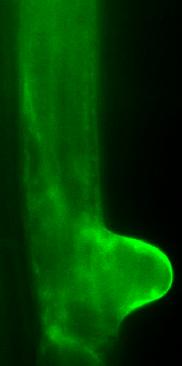Scientists at the John Innes Centre in Norwich have discovered how roots find their way past obstacles to grow through soil. The discovery also explains how germinating seedlings penetrate the soil without pushing themselves out as they burrow.
“The key is in the fuzzy coat of hairs on the roots of plants” says Professor Liam Dolan. “We have identified a growth control mechanism that enables these hairs to find their way and to elongate when their path is clear”.
Root hairs explore the soil in much the same way as a person would feel their way in the dark. If they come across an obstacle, they feel their way around until they can continue growing in an opening. In the meantime, the plant is held in place as the hairs grip the soil.

This ability is governed by a self-reinforcing cycle. A protein at the tip of root hairs called RHD2 produces free radicals that stimulate the uptake of calcium from the soil. Calcium then stimulates the activity of RHD2, producing more free radicals and further uptake of calcium. When an obstacle blocks the hair’s path, the cycle is broken and growth starts in another location and direction.
“This remarkable system gives plants the flexibility to explore a complex environment and to colonise even the most unpromising soils”, says Professor Dolan.
“It also explains how seedlings are able to grow so quickly once they have established”.
In nutrient poor soils such as in parts of Australia and sub-Saharan Africa, plants have adapted by producing more root hairs. A better understanding of this adaptation will allow the development of crops able to grow in inhospitable environments.
This research was funded by the BBSRC, a Marie Curie International Incoming Fellowship and MEXT of Japan.






Comments